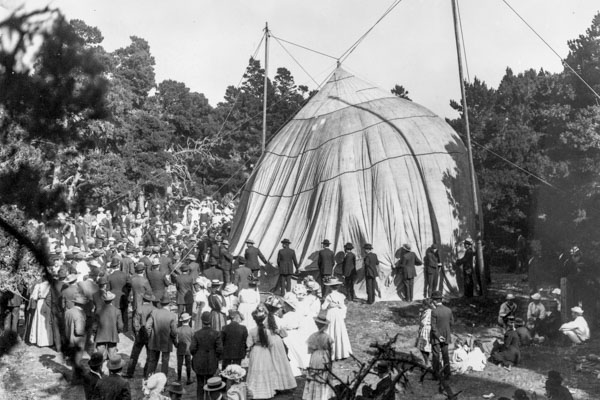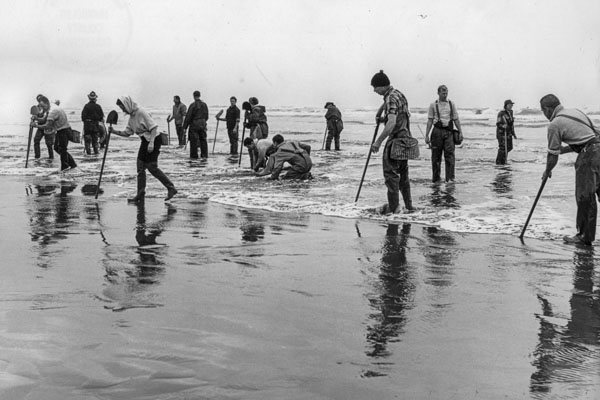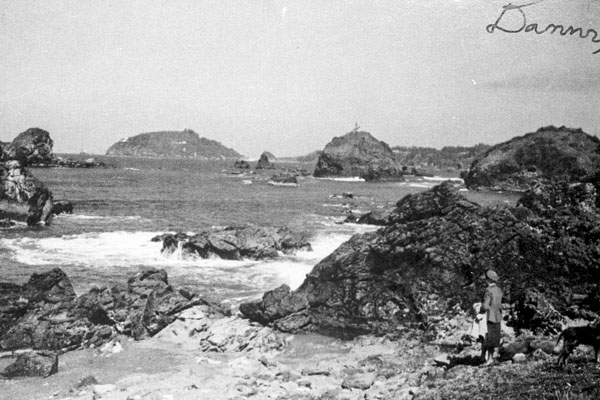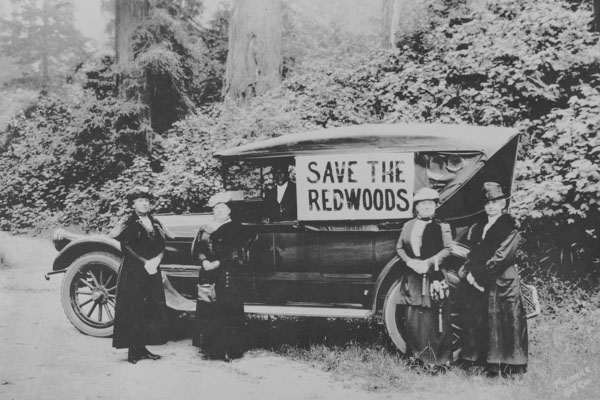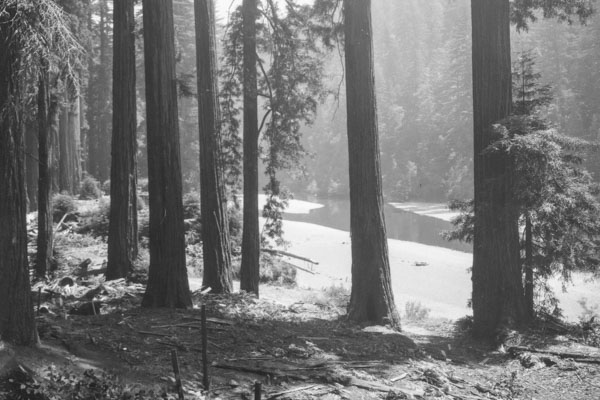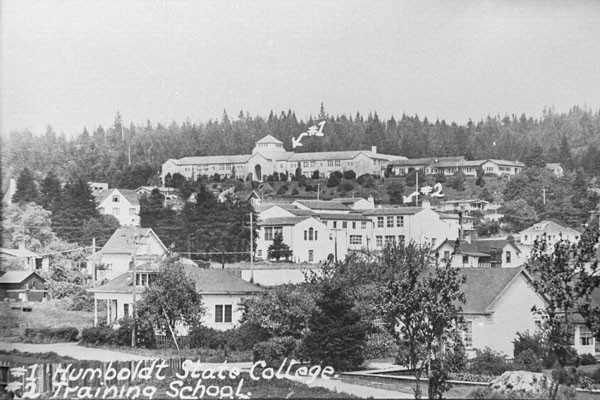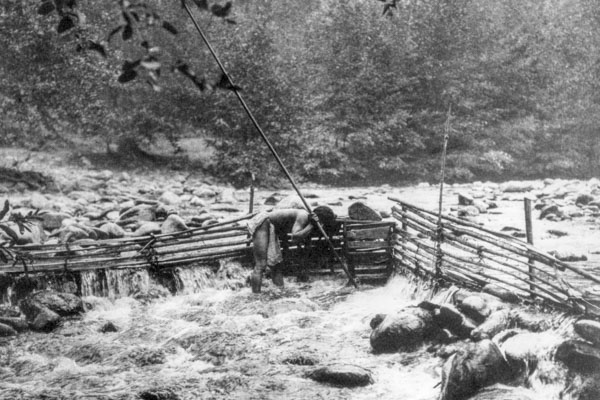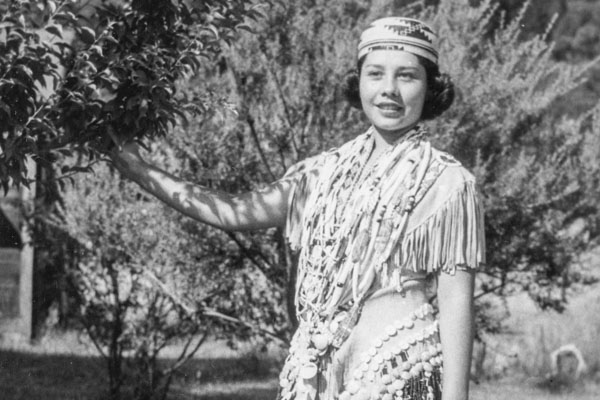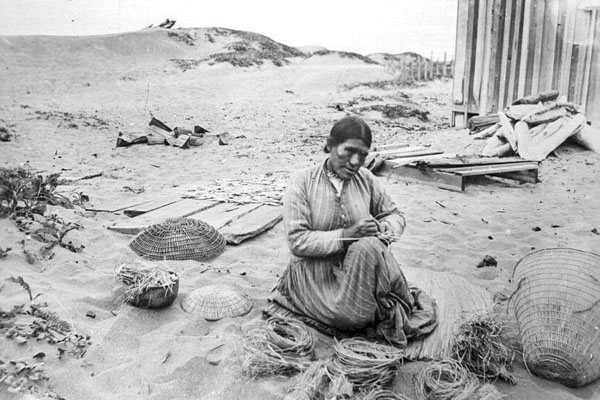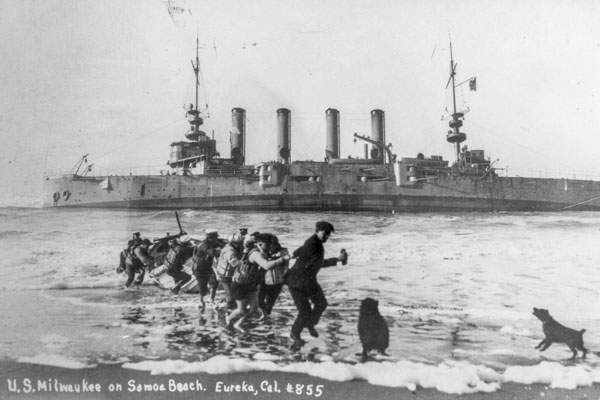You are here
Conservation as Formerly Practiced by the Indians in the Klamath River Region
Roberts, Ruth Kellet / Conservation as Formerly Practiced by the Indians in the Klamath River Region. California Fish and Game. Sacramento, October, 1932. Volume 18, No. 4, pp. 283-290
The Indians subsisted on the resources which nature provided. Where natural resources were bountiful, the population was most numerous. Streams and areas that abounded in food supplies became, naturally, the permanent abodes of the Indian.
The lower Klamath River region supplied all the necessities of food, shelter, clothing, and materials for utensils, which their mode of life required. Through its entire length the Klamath River drainage area was supplied with foods in great abundance and variety. The waters of the river teemed with fish and the neighboring forests abounded in deer and other game. A rich supply of acorns was furnished by the oaks; and grass seeds, pine nuts, and berries were easily obtained. The Indian name for the river itself is said to have meant "abundance," and it naturally followed that this locality supported many thriving Indian settlements. The density of the pre-white population of this region was noted and commented upon in the early investigations of Stephen Powers1, and in the later studies of A.L. Kroeber2.
During the acorn gathering season, the population migrated to areas where the oak trees were most numerous and frequently established camps there. Similar excursions were made for the purpose of gathering grass seeds, pine nuts, sea weed, berries, and other necessities.
Regard for property rights among them was very mich higher than it is among some of our more civilized people. They were not obliged, upon their return to their established homes, to make an inventory of the depredations committed upon their property during their absence.
An exchange of products among the Klamath River Indians amounted to a commerce which provided all groups with such supplies as they were in need of. Sea weed and other ocean foods were exchanged by the Indians living near the mouth of the river for such necessities as were more plentiful along the upper stretches of the stream.
The Indians, of necessity, avoided diminution of any natural resources upon which their life depended. Public opinion and community law disapproved of any waste. Trees were felled only for construction of canoes and houses, and dry brush and sticks were used for firewood. Seasonal burning over of certain areas was related to their mode of farming, as it served to produce grass seeds for food, and hazel twigs and grass for basket weaving. This was done every two years. It also protected their game by destroying the underbrush shelters of predatory animals. Systematic burning did much to rid the immediate neighborhood of rattlesnakes, mountain lion and bear, and to check the increase of insect life.
To destroy wild life for any other reason than to meet his need of food would have been as ridiculous a procedure to the Indian as if we entered our own gardens or went among our own herds and destroyed for the sheer enjoyment of our prowess as destroyers.
This "happy hunting ground" of the Indian showed no depletion of its remarkable resources of fish and game until after the advent of the whites.
In contrast to the white man's idea of sportsmanship, the Indian killed only what he needed for food, and he wasted no edible parts of the game taken by him. Even the entrails of animals were dried for winter food for the dogs. Any one who caught more fish or killed more game than he and his family could use shared it with others who were less fortunate. To the Indian, hunting was not a sport; it was a means of obtaining his food supply, and the killing of wild life was limited to his necessity for sustenance. To destroy this supply meant nothing short of self-destruction.
The white pioneers of this region killed off great herds of elk and deer for their hides and left the carcasses to be devoured by the buzzards. The modern "sportsman" catches steelhead and salmon for the "sport," and in many cases takes a quantity far greater than he has nay use for and leaves them on the shore to rot. Prowess as a killer of wild life is still mistaken by many as an indication of superior sportsmanship. This notion is very largely an inheritance from early days in the West, when wild life was plentiful and when boastful satisfaction was proportionate to the killer's skill in destroying it.
A Yurok legend tells that woman held the hidden knowledge of the source of food supply and guarded this secret jealously. In this respect Indian tradition agrees closely with the belief that prevailed generally among other races at the dawn of history.
The origin of the most important food supplies, such as salmon and acorns, is accounted for by legend. According to the Indians, the Klamath River at one time emptied at the site of the old Indian village of "Omen," at the mouth of Wilson Creek, four or five miles north of the present outlet, but no fish entered there and the Indians were hungry. The Creator, seeing their plight, shifted the river mouth to it's present location and brought "Oregos" (a tall rock shaped like a woman) from "Omen" to "Rekwoi," the Yurok village at the present mouth, and placed this rock for "luck," and as guardian of the river. Still there were not fish/ and so "Oregos," at the suggestion of an Indian boy who had been prompted in a dream, went across the ocean by canoe to another land, and brought back a charmed fishing rock. This was divided by "Oregos" into two sister rocks, with identical names. One was placed at the base of "Oregos" on the north side of the river, and the other near the foot of the hills on the opposite side of the stream, marking the limits within which the river at various times shifts its outlet. After the placing of these rocks, fish came into the stream, and the annual runs have continued ever since.
The food supply was regarded as the gift of the Creator, and the taking of fish was a solemn and prayerful undertaking, governed by very strict formulae. The first salmon to enter the Klamath in the spring was permitted, with elaborate ceremony, to pass up the river, as the Indians believed this fish acted as a leader for the run to follow. It was thought that this salmon in its ascent to the spawning grounds left scales on the rocks to indicate the route which the salmon entering later should follow, so that the Indians up river would be assured of a food supply. Other leaders, and then the whole run of salmon, followed, leaving their scales; and by the time they reached the spawning grounds they were battered and exhausted.
One of the earliest, if not the earliest, observations to be made of the condition of the salmon in the spawning stream, is that recorded in the diary of the overland party of the Wilkes' Exploring Expedition, early in October, 1841. According to this record these explorers purchased two salmon which the Indians had taken from the Shasta River. Their description of the fish is: "The Salmon were of whitish color, and not at all delicate to the taste; their tails were worn off, and the fish otherwise bruised and injured."
References are made in Indian lore to seasons when there was a limited run of fish. One tale, antedating the coming of the white man, tells of a war between the Tolowa Indians of Smith River and the Karok Indians of the Klamath, brought on as a result of the fact that the fish, in this particular year, had entered the Klamath, but not the Smith River. The Tolowas blamed the Karoks for this calamity. About 1200 warriors from Smith River crossed over by the trail that later became known as the Kelsey trail, and descended upon the village at what is now Happy Camp, burned the houses, killed as many of the inhabitants as they could, took the Karok food supplies and canoes, and started down the river. News of this attack reached the Indians down stream, who closed in upon the marauders in the gorge at Ishipishi Falls, and killed all but three of them.
Another legend tells of a great famine that spread among the Indians along the entire lower stretches of the Klamath River, when no fish or eels came in. Other food sources had also failed. Even the mussels were blasted, and there were no acorns. In the belief that three sisters who resided at the Yurok village of "Rekwoi" had secret knowledge with which they had prevented the entrance of the fish, the Karoks and Hoopas descended upon the village before the inhabitants were awake, and set fire to the houses. Many Yuroks, both men and women, were killed, and a great war involving the whole region from Smith River to Orleans and Hoopa resulted.
The food supply sources were not in all cases common property. Many of the acorn producing groves and grass seed and brodea patches were owned by individuals and by family groups. Since salmon was an important part of the food supply of the Indians on the river, individual and family ownership of fishing places developed and was scrupulously respected. A single fishing place was sometimes held in joint ownership by several individuals or families. The women and girls did not fish, but assumed responsibility for smoking and drying the catch. Persons who did not own a fishing place, or who were not allowed dipping privileges, by the owners of such places, were given fish in payment for assistance rendered to those who had such rights.
Ownership of these fishing places could be transferred by will for care in old age or during illness, and could be sold. Ownership was sometimes staked in gambling and lost, and was sometimes given in advance payment to an Indian doctor. Good doctors became very rich, both in possession of fishing places and in Indian money and flints. Among some Indian groups there was a law against a doctor exacting mortgage on a fishing place, or acquiring a fishing place in advance payment for "doctoring."
Besides the individual ownership of fishing place, there were community projects, such as at the mouth of the Salmon, in the pools below Ishipishi Falls, and the fish weirs at "Lo-olego" (an Indian village just above Weitchpec, now extinct) and at Kepel. Jedediah S. Smith's party of American trappers recorded the presence of a "fishing establishment" in the vicinity of Weitchpec, in May 1828, which was probably the one at "Lo-olego3."
Frequent mention is made throughout Smith's diary of the volume of water observed in all of the streams of this area, which would indicated that in 1828 a very much larger flow existed than at present.
A fish weir was put in at Kepel in September, and was allowed to remain until carried away by high water, about a month later. The weir consisted of a series of traps extending across the river with space at either end, near the banks, wide enough to allow canoes to pass. This space also permitted the passage of fish. Many fish jumped over the weir, which projected about three feet above the surface of the river, and made their way up stream.
The several important family who sponsored the construction of the weir had prior dipping rights. They took what fish they wished each morning, and were followed by those who possessed no fishing places or privileges4.
At the height of the run, when there was danger of the dam being broken by the crowding of fish against it, the traps were opened after the day's fishing, and the fish allowed to pass through until the next morning. Indians in great numbers from a considerable distance up and down the river gathered here for the annual fishing event and for the merrymaking that accompanied it.
At the mouth of the Salmon, and in the pools below Ishipishi Falls, quantities of salmon were taken in dip nets. In the fall, Indians came here from great distances to fish. It has been reported that the salmon were so numerous that thirty or forty people at one time were taken in a net, and that several men were required to drag the catch to shore.
Another instance of the recognition of established community rights with respect to a food source is mentioned by Kroeber5. This was in the case of whales that were occasionally washed up along the Humboldt and Del Norte coast. The tribal boundaries determined the group ownership of the whale carcass. Each man took a cut a half fathom wide, and the rich man, a full fathom.
In describing methods of fishing, Kroeber states6:
"The dip net, or lifting net, as it may be called to distinguish it from a smaller instrument on an oval frame occasionally used by the Karok and other tribes to scoop boiling riffles and rapids (Pl.6), was let down from a scaffolding built out over the water, almost invariably at some eddy or backwater. Here the fisherman sat on a block or little stool, holding the bone button of the string which closed the entrance to the pyramidal net stretched out in the current. This net was hung from the bottom of a long A-shaped frame with a bottom crossbar. The whole was hauled out as soon as a pull on the cord had inclosed a salmon, which was then struck on the head with a club. A single night's vigil sometimes produced a hundred salmon, it is stated--a winter's supply, as the Yurok say. At other times a man will sit for half a day without a stir. The old men are much inclined to this pursuit, which would be trying to our restless patience, but gives them opportunity for undisturbed meditation or dreaming or mental idleness along with a sense of profitable occupation. (Pls. 4, 7)
"Lampreys, customarily known as eels, much prized by the Yurok for their rich greasiness, also ascend the river in great numbers, and sturgeon are not rare. Both species are taken much like the salmon, though of course with a net of different mesh. In the lower river eelpots were also set. Trout in the affluent creeks are too small to be much considered by a people frequently netting 20-pound salmon.
"Both salmon and lampreys were split for drying--the former with a wooden-handled knife (Pl. 16) of 'whale-colored' flint, as the Yurok called it; the latter with a bone awl. A steel knife probably involves a different and perhaps a more precise handling, so that until a few year ago the old women clung to the aboriginal tools. Most of the fish was somewhat smoked and put away in old baskets as strips or slabs. The pulverized form convenient for packing, known also on the Columbia, was probably more prevalent among interior and less settled tribes like the Shasta. Surf fish were often only sun dried whole and kept hung from poles in rows. They make a palatable food in this condition. Dried salmon is very hard and nearly tasteless, but rather satisfying and, of course, highly nourishing.
"A long net was sometimes set for sturgeon. One that was measured had a 6-inch mesh, a width of 3 feet, and a length of 85 feet, but in use was doubled to half the length and double the width.
"A measured salmon seine had a scant 3-inch mesh, a width of 3 1/2 feet, and a length of over 60 feet.
"Nets were made of a splendid two-ply cordage rolled without tools from fibers of the Iris macrosiphon leaf. The gathering of the leaves and extraction of two fine silky fibers from each by means of an artificial thumb-nail of mussel shell was the work of women. The string was usually twisted and the nets always knotted by men. The mesh spacer and netting shuttles were of elk antler; net weights were grooved, pierced, or naturally perforated stones. (Fig. 7)
"The salmon harpoon, which could be more frequently used in the aboriginal period than now when mining renders the river opaque, had a slender shaft, sometimes more than 20 feet long. To this were attached two slightly diverging fore-shafts, one a few inches the longer, on which were set the loose barbs of pitched and wrapped bone or horn. The lines were short and fastened to the main shaft, a pay line being unnecessary for prey the size of a salmon. In fact, an untoggled barbed spear would have sufficed but for the opportunity its resistance offers a heavy fish to tear itself free. This harpoon was made with no essential variation in practically all fishable parts of California, and it is the only harpoon known, except for a heavier implement driven by the Yurok and Chumash into sea lions."
In small streams fish dams were made of green poles with a fill of brush and rocks, but always with one end of the barrier free from the shore, which permitted the passage of fish.
Trout were caught in a V-shaped set basket which looked like a dip net. Set baskets were also used for trapping eel. These were set in the river and emptied at intervals.
The Indian fished practically throughout the entire year. No limit to the catch was imposed other than that determined by the needs of the person or family fishing. Fishing rights were determined by ownership (or lack of ownership) of a fishing place, possession of extended fishing privileges, or accessibility to a common fishing place.
Salmon were permitted to pass up the river for a half moon before any were caught. Most of the spring salmon were allowed to pass, except what was wanted for immediate use. This run was so rich in oil that the fish did not keep when smoked. The summer and fall salmon were preferred for drying. This may have been because they contained less oil and particularly for the reason that by taking the later run the winter food supply need not be carried through the warm summer.
Open deer season was fixed at a time in the fall when wild celery seeds were ripe. Deer and elk were trapped in pits or snares, or were taken with the aid of dogs. If bucks could be found, does were not killed. Each family killed as many as it could use. All surplus meat was jerked for winter use. Quail and grouse were not taken during the nesting period unless a family was starving. There were not restrictions upon the taking of eels.
It was an established belief among the Indians of the lower Klamath River region that any person who violated accepted fish and game regulations would "loose his luck" as a hunter or fisherman, or would not live to hunt or fish another season. This belief had a very restraining effect. The conservation of fish and game on the Klamath River, as elsewhere, is very largely a struggle to restrain the white man in his delight in killing.
[photo]
Fig. 65. Trolling at the mouth of the Klamath River.
[photo]
Fig. 66. Looking up the Klamath River from Requa. Red Mountain in the distance.
[photo]
Fig. 67. Eel traps used on the Klamath River.
Footnotes:
1"Tribes of California," Cont. N. Am. Ethnology, vol. III, Washington, 1877, Stephen Powers.
2Bureau of American Ethnology, Bulletin 78, Handbook of the Indians of California, A.L. Kroeber.
3Dale, The Ashley-Smith Explorations.
4Originally the weir was equipped with eight traps, but with the decrease of Indian population the number of traps diminished to four.
